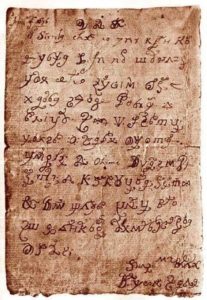The Devil and the Nun
On the morning of August 11, 1676, a young nun named Maria was found on the floor of her cell. Her face was smeared with ink. Her hand held a sheet of paper covered with inscrutable glyphs. She told the other nuns that the Devil appeared to her in the night and tried to turn her away from her faith. To persuade Maria, the Devil took over her facilities and wrote a letter with her hand. The writing was not in Latin or any familiar language. It was a mysterious jumble of occult symbols and archaic letters. No one was able to decipher the letter by the Devil. 
Sister Maria Crocifissa della Concezione was 15 years old when she entered the Benedictine convent in Palma di Montechiaro, Sicily. She was 31 at the time of the Devil’s visit. Maria had a history of struggling against the Devil. She would scream at him at night. In the convent’s chapel, she would shriek and lose consciousness. She was convinced that Satan was trying to turn her towards evil.
In 2017, director Daniel Abate and a research team from the Ludum science center in Catania, Sicily cracked the code. They used an algorithm found on the Deep Web. “We heard about the software,” Abate said, “which is used by intelligence services for coding breaking. We primed the software with ancient Greek, Arabic, the Runic alphabet and Latin to descramble some of the letter.” The team was eventually able to translate 15 lines, which were certainly devilish for a nun to express:
“Humans are responsible for the creation of God.”
“This system works for no one.”
“God thinks he can free mortals.”
“Perhaps now, Styx is certain.”
“God and Jesus are dead weights.  ”
”
“We speculated that Sister Maria created a new vocabulary using ancient alphabets that she may have known,” Abate said. “This is a precise alphabet, invented by the nun with great care by mixing symbols that she knew. We analyzed how the syllables and graphisms (or thoughts depicted as symbols) repeated in the letter in order to locate vowels, and we ended up with a refined decryption algorithm.” Abate thought Sister Maria had a good command of languages, which allowed her to invent the code. There is no information on what happened to her after the incident.
The letter was an elaborate hoax by Sister Maria. Why did she do it? How was she sure that she would not be found out? If she knew ancient alphabets, didn’t any of the other nuns at her convent know them as well? Abate believes the nun had schizophrenia, which made her imagine dialogues with the Devil.
Here’s my guess across 344 years: She was frustrated, pent-up, tormented by sexual desires or guilt. She had some doubts about the faith, which bothered her. Her small stage as a woman and as a nun bothered her. She was conflicted, she wanted attention, and she acted out her doubts and obsessions. The Devil was a good prop. Once she started with the screams and convulsions, she had to keep it up. She probably wanted to keep it up; the letter was a good finale. She won her fight against Satan and became a heroine in the convent.
Sister Maria most likely heard about other demonic possessions and Satanic letters in other convents. The 17th century was full of them, all featuring young nuns tempted by sex and heresy including Aix-en-Provence in 1611; Lille in 1613, Loudon in 1634 and Louviers in 1647. They are full of real and imagined seductions by priests and other nuns. I am surprised that no one has thought to do a full-blown historical and psychological study on these possessions, and their links with sex, female rebellion, and church politics.
